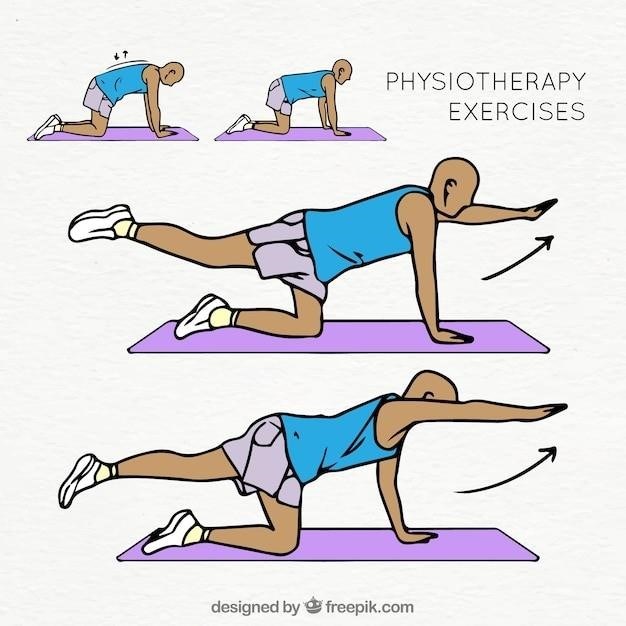Gluteus Medius⁚ Anatomy and Function
The gluteus medius‚ a hip muscle‚ plays a crucial role in daily activities and higher-level functions like sports and weightlifting. Its location on the outer hip aids stability and movement. Strengthening it improves posture and reduces injury risk.
Location and Role in Daily Activities
The gluteus medius is situated on the outer hip‚ between the gluteus minimus and maximus. Its primary function is hip abduction‚ moving the leg away from the body’s midline. This action is crucial for walking‚ running‚ and maintaining balance during everyday movements. A weak gluteus medius can lead to compensatory movements in other muscles‚ potentially causing pain in the knees‚ hips‚ or lower back. Proper functioning of this muscle is essential for stable gait and efficient movement patterns. Daily activities such as climbing stairs or standing on one leg heavily rely on the gluteus medius’s ability to stabilize the pelvis and control hip movement. Neglecting this muscle can lead to instability and increased injury risk.
Importance in Higher-Level Activities (Sports‚ Weightlifting)
In sports and weightlifting‚ a strong gluteus medius is paramount for optimal performance and injury prevention. During running‚ jumping‚ and lateral movements‚ it provides crucial hip stability‚ preventing unwanted pelvic tilting and knee collapse. Weightlifting exercises like squats and lunges heavily rely on the gluteus medius to control hip abduction and maintain proper form‚ preventing strain on the knees and lower back. Its role in single-leg activities‚ such as those seen in many sports‚ is critical for maintaining balance and power. Weakness in this muscle can lead to decreased athletic performance‚ increased injury risk‚ and inefficient movement patterns. Therefore‚ targeted strengthening and stretching are vital for athletes and weightlifters to achieve peak performance and reduce the likelihood of injury.
Gluteus Medius Weakness⁚ Symptoms and Causes
Weakness in the gluteus medius can manifest as low back pain‚ knee pain‚ hip instability‚ and altered posture. Causes include muscle imbalances‚ injury‚ and prolonged sitting.
Connection to Low Back and Knee Pain
A weak gluteus medius can significantly contribute to low back and knee pain. When this muscle is underperforming‚ it fails to adequately stabilize the pelvis and hip‚ leading to compensatory movements in the lower back and knees. This increased strain on these joints can result in pain and discomfort. The altered biomechanics caused by gluteus medius weakness can place excessive stress on the lower back‚ potentially causing muscle spasms‚ disc problems‚ and facet joint pain. Similarly‚ the knee joint may experience increased stress‚ leading to patellofemoral pain syndrome or other knee injuries. Therefore‚ strengthening the gluteus medius is often a key component in treating and preventing lower back and knee pain. Addressing gluteus medius weakness is crucial for restoring proper biomechanics and alleviating pain.
Impact on Hip Stability and Posture
The gluteus medius muscle is essential for hip stability and maintaining proper posture. Its primary function is hip abduction‚ the movement of the leg away from the body’s midline. Weakness in this muscle can lead to decreased hip stability‚ increasing the risk of injury‚ particularly during activities requiring single-leg stance or weight-bearing on one leg. This instability can manifest as a noticeable “hip drop” during walking or standing on one leg‚ indicating the gluteus medius is not adequately supporting the pelvis. Furthermore‚ a weak gluteus medius often contributes to poor posture‚ potentially resulting in pelvic tilt‚ increased lumbar lordosis (swayback)‚ and altered spinal alignment. Strengthening this muscle improves hip stability‚ enhances balance‚ and promotes better posture‚ reducing pain and the risk of future injuries.

Gluteus Medius Strengthening Exercises
Several exercises effectively target the gluteus medius‚ improving hip stability and strength. These include single-leg bridges‚ clamshells‚ and side-lying hip abductions‚ all easily performed at home.
Single Leg Bridge⁚ Technique and Benefits
The single-leg bridge is a highly effective gluteus medius strengthening exercise. Begin by lying on your back with knees bent and feet flat on the floor. Extend one leg straight up towards the ceiling‚ keeping your hips square. Engage your core and glute muscles‚ lifting your hips off the floor until your body forms a straight line from shoulders to knees. Slowly lower your hips back down‚ maintaining control. This exercise improves hip abduction strength and stability‚ crucial for individuals with gluteus medius weakness or tendinopathy. Remember to maintain proper form throughout the movement to maximize benefits and prevent injury. Repeat for the recommended number of sets and repetitions‚ focusing on the controlled movement and glute activation. This exercise is a great way to build strength and stability in the hip‚ contributing to improved overall lower body function and injury prevention.
Clamshells and Side-Lying Hip Abduction
Clamshells and side-lying hip abductions are excellent exercises for isolating and strengthening the gluteus medius. For clamshells‚ lie on your side with knees bent at a 90-degree angle and feet stacked. Keeping your feet together‚ lift your top knee‚ opening your legs like a clamshell. Slowly lower your knee back to the starting position. Side-lying hip abductions involve lying on your side‚ supporting your head with your arm‚ and lifting your top leg straight up‚ maintaining a straight line from hip to ankle. Lower slowly and repeat. Both exercises effectively target the gluteus medius‚ improving hip stability and reducing the risk of injury. Focus on controlled movements and feel the muscle activation in your hip to maximize effectiveness. These exercises are particularly beneficial for individuals recovering from injury or experiencing gluteus medius weakness.

Gluteus Medius Stretching⁚ Techniques and Benefits
Regular gluteus medius stretching improves hip mobility‚ alleviates pain‚ and enhances overall lower body flexibility. Targeted stretches relieve tightness and improve posture‚ preventing future discomfort.
Effective Stretches for Tight Hips and Buttocks
Several stretches effectively target the gluteus medius and surrounding hip muscles. The “Figure Four” stretch‚ performed lying on your back‚ involves crossing one leg over the other and gently pulling the knee towards your chest. This directly targets the outer hip. A standing hip flexor stretch‚ where you lunge forward while keeping your back straight‚ indirectly helps alleviate gluteus medius tightness by releasing tension in opposing muscles. Additionally‚ a simple side-lying hip abduction stretch‚ where you lift your top leg away from your body‚ isolates the gluteus medius for a focused stretch. Remember to hold each stretch for at least 30 seconds‚ breathing deeply‚ and avoiding any sharp pain. Consistency is key for lasting relief and improved mobility.
Improving Hip Mobility and Pain Relief
Regular gluteus medius stretching significantly improves hip mobility and can alleviate pain stemming from tightness in this area. Increased flexibility in the hips translates to better posture‚ reducing strain on the lower back and knees. By releasing tension in the gluteus medius‚ stretches can address pain caused by muscle imbalances or overuse. Improved hip mobility allows for a greater range of motion during daily activities and exercise‚ reducing the risk of injury. Furthermore‚ consistent stretching can enhance athletic performance by optimizing hip function. The reduction in pain and improved movement contribute to an overall enhanced quality of life and increased physical comfort.
Assessing Gluteus Medius Strength
Various methods exist to measure gluteus medius strength‚ including single-leg stance tests and isometric exercises. Accurate assessment helps determine the need for strengthening programs and monitors progress.
Methods for Measuring Muscle Strength
Several methods assess gluteus medius strength. One common approach involves observing the patient’s ability to maintain a single-leg stance for a specified duration‚ noting any compensatory movements indicating weakness. Isokinetic dynamometry provides objective measurements of muscle force production at various speeds‚ offering a precise assessment of strength. Functional tests‚ such as the Trendelenburg test‚ evaluate the gluteus medius’s role in hip stability during weight-bearing activities. Electromyography (EMG) measures the electrical activity of the muscle‚ providing insights into muscle activation patterns. These diverse techniques allow for a comprehensive evaluation of gluteus medius strength‚ tailoring rehabilitation programs to individual needs.
Interpreting Assessment Results
Interpreting gluteus medius strength assessments requires careful consideration of multiple factors. The duration of a single-leg stance‚ for instance‚ reflects overall hip stability and gluteus medius function. Dynamometry results are compared to normative data for age and gender‚ identifying deficits in maximal voluntary isometric contraction (MVIC). EMG data reveals the timing and intensity of muscle activation‚ detecting potential neuromuscular impairments. Functional test results‚ such as those from the Trendelenburg test‚ help determine the muscle’s role in maintaining pelvic stability during weight-bearing activities. Combining these assessments provides a comprehensive understanding of gluteus medius strength and any associated functional limitations‚ guiding targeted interventions.
Incorporating Gluteus Medius Workouts
Integrate gluteus medius exercises into your routine for injury prevention and rehabilitation. Prioritize proper form to maximize benefits and minimize risk of further injury.
Integrating Exercises into Resistance Training Programs
Incorporate gluteus medius strengthening exercises into your resistance training program to enhance overall lower body strength and stability. Include exercises like single-leg bridges‚ clamshells‚ and side-lying hip abductions. These can be added to your existing routine or used as part of a warm-up. Start with lighter weights or resistance bands and gradually increase the intensity as you get stronger. Focus on maintaining proper form to avoid injury. Remember that consistency is key‚ aiming for at least two to three sessions per week. Pay attention to your body and adjust the intensity or exercises as needed. Consider incorporating these exercises into your cool-down as well‚ promoting flexibility and reducing muscle soreness.
Considerations for Injury Prevention and Rehabilitation
Preventing gluteus medius injuries involves incorporating regular strengthening and stretching exercises into your routine. Proper warm-up before activity is crucial‚ preparing the muscles for exertion. Focus on maintaining correct form during exercises to avoid strain. Gradual progression is essential; avoid overtraining‚ allowing for adequate rest and recovery between sessions. Listen to your body and cease activity if pain occurs. In rehabilitation following an injury‚ start with gentle stretches and low-impact exercises‚ gradually increasing intensity as tolerated. Consult with a physical therapist for a personalized rehabilitation plan tailored to your specific needs and injury type; They can guide you through safe and effective exercises to restore strength and function. Consistent effort is key to successful rehabilitation and long-term injury prevention.